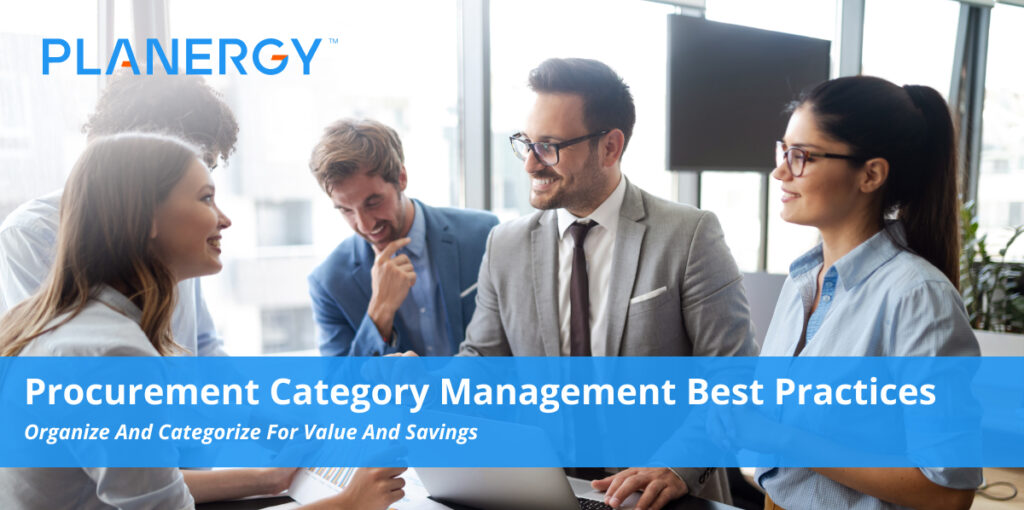In a data-driven global economy, chief procurement officers (CPOs) and other procurement professionals are eager to identify opportunities to support the business needs and goals of their organizations through well-optimized procurement processes.
One of the most important ways in which a company can streamline its procurement strategy for both cost savings and value creation is through effective category management.
If your procurement team is ready to gather deeper insights into its spend, develop more effective workflows, and streamline your supply chain to support your organization’s business needs and goals, take a few moments to learn more about how the best practices in procurement category management can help.
Why Category Management Is Important in Procurement
Touching every business unit, department, and project in your business, the procurement function offers rich opportunities for greater value, cost savings, and improved competitive performance across its many workflows and processes.
What you’re spending is important, but knowing where you’re spending—and how effectively you’re doing so in each area of spend—has particular value for those looking for strategic improvements as well as cost savings.
Category management—the process of organizing spend into distinct areas for greater focus and more detailed analysis of the goods, services and suppliers involved in each area—gives procurement professionals a much more nuanced view of spend.
These categories are based on which areas of the business they support.
By sorting spend into categories such as professional services, human resources, information technology (IT), etc., category managers can:
- Track total spend within each category.
- Identify which business needs this spend meets (or fails to meet).
- Identify key suppliers and engage in mutually beneficial strategic partnerships that promote collaboration and innovation.
- Create key performance indicators (KPIs) and use them to monitor and track vendor performance and compliance.
- Identify opportunities for process improvement.
- Help to eliminate tedious, time-consuming tasks through greater supply chain visibility, collaboration between category managers, and more effective spend data management (including the use of digital tools).
- Streamline the entire procure-to-pay (P2P) process for all vendors in your supply base.
- Generate long-term gains to competitive advantage, productivity, and profitability through continuous improvement, more strategic sourcing, and improved risk management.
Whereas strategic sourcing seeks to provide value to an organization using a reactive approach (modifying spend behaviors and strategies using analysis of existing data sets), category management is inherently proactive.
It requires category managers to possess a well-developed understanding of their respective categories, and use that knowledge to optimize processes and engage with suppliers to identify ways to reduce wasted time and resources, eliminate human errors, and assert control over spend through a blend of forward-looking spend strategies and data analysis.
Category management—the process of organizing spend into distinct areas for greater focus and more detailed analysis of the goods, services and suppliers involved in each area—gives procurement professionals a much more nuanced view of spend.
Procurement Category Management: Best Practices
When considering the best practices for procurement category management, it’s important to remember that every business has its own approach to both overall procurement strategy and the category management process itself.
However, every organization can benefit from the strategic application of a few essential best practices when crafting their category management process.
1. Secure and Maintain Stakeholder Buy-In
One of the more significant obstacles to successful category management implementations is resistance from internal stakeholders who regard the changes necessary to support such an implementation as less than cost effective.
Management may not realize the value created by category management, or hold traditional views of procurement as a source of cost savings rather than value.
It’s worth the effort to educate stakeholders at all levels regarding the benefits of effective category management, however—particularly as part of an overarching procurement optimization strategy.
By shifting focus to collaborative, proactive, and strategic supplier relationship management, it’s easy to develop category strategies providing demonstrable value through:
- Improved spend and project management across departments and business units, with stakeholders working with their assigned category specialist(s) to obtain the best possible pricing and terms.
- Development of self-service, guided buying experiences based on budget thresholds and role-appropriate access, eliminating bottlenecks for frequent purchases, combatting rogue spend, and improving overall efficiency while still capturing spend data for analysis.
- Centering procurement as a value center through centralized spend data, a unified software environment, and direct involvement in project and budget planning at all levels.
- Improving risk management and supporting business process management through the use of process automation, artificial intelligence, and deep data analytics (via procurement software tools) to track and manage vendor performance and compliance.
- Development of a supplier relationship management program that allows for a balanced approach when developing strategic and mutually beneficial relationships with key suppliers while simultaneously providing open and clear communication with non-critical suppliers.
2. Formalize Your Category Management Process.
No two category management strategies will be the same, but you can craft one that best suits your business needs and goals by addressing a few key areas.
- Defining Spend Categories. Which categories and subcategories within your supply chain require management? Examples include Human resources, Security, Medical, Professional Services, Travel and Entertainment, etc.
- Spend Analysis. How will spend be tracked and managed within each category and subcategory? What tools will be required to do so with maximum strategic value and minimum additional expense? Which suppliers are most important to business continuity, innovation, and growth?
- Market Analysis. What is the condition of each category and subcategory’s supply market? What vulnerabilities exist that could potentially disrupt the supply chain? What can category managers do to preserve business continuity and enhance supply chain resilience while minimizing supply chain risk?
- Continuous Improvement. What insights are revealed through analysis of spend and market intelligence? What processes must be established to provide category managers and other stakeholders with the tools necessary to adjust the supply chain to meet changing needs, solve problems, and pursue revealed opportunities while still pursuing positive and collaborative relationships with key suppliers?
3. Invest in Procurement Software Tools
In the age of digital transformation, paper-based procurement activities and spend data that’s siloed—rather than strategically sorted—are a recipe for competitive and financial disaster.
To fully take advantage of the benefits of category management, you need digital tools that allow you to manage your supply base with a strategic approach to supplier relationships, spend analysis, and your entire sourcing process.
Implementing a modern procurement software solution such as PLANERGY helps procurement professionals set and achieve concrete goals for cost savings and value creation by leveraging advanced analytics, robotic process automation, and artificial intelligence.
Using category management and supplier relationship management tools, you can:
- Centralize all your procurement data—including all your spend data, supplier data, and market intelligence—into a single, cohesive datasphere for easy and comprehensive analysis that grows more accurate and useful as it grows.
- Integrate your procurement function with other software applications to create a shared software environment where it’s easier to see and share information.
- Customize your category management approach in real-time based on feedback from data analysis. Create specific spend categories and subcategories, prioritize key suppliers, and diversify or consolidate your supply base as circumstances demand.
- Create vendor management KPIs to track supplier performance and compliance, and make the supply chain management decisions necessary to protect operations, minimize supply chain disruptions in specific categories, or provide contingency-based insulation against global supply chain disruptors such as natural disasters or the COVID-19 pandemic.
- Use vendor portals to connect vendor systems to your own, allowing the use of punch-out catalogs, improved contract management capabilities, etc.
- Work with team leaders and management at all levels to improve decision making, identify opportunities for growth and innovation, and promote knowledge about, and support for, digital transformation throughout your organization.
4. Build a Foundation for Best-in-Class Business Process Management
While effective category management is only a small part of a strategic approach to procurement optimization, it directly supports your company’s competitive strength in the digital age.
By centralizing your data management, providing rich insights that drive more strategic sourcing and better decision making, and making continuous improvement and collaborative communication standard operating procedure, category managers lead the way in fostering a value-centered, proactive environment where every iteration is a new opportunity for greater savings and success.
In such an environment, it’s much easier for stakeholders to see and understand how data analytics, automation, and other digital tools can give your organization an invaluable edge, whether you’re consolidating your supply chain, developing new products and processes with a key supplier, or slashing purchase order cycle times (and saving time, money, and resources) through guided buying.
Streamline Category Management to Maximize Procurement Performance
A place for everything, and everything in its place. When your procurement team makes strategic use of category management, you’re taking a proactive and data-driven approach to managing and optimizing your spend.
Take the time to develop and follow your own procurement category management best practices, and gain greater clarity into your spend, more valuable insights from your spend data analysis, and a boost to both competitive strength and profitability through increased supply chain efficiency and effectiveness.




